With its WordPress plugin, Cirrus Shield allows you to put online forms integrated into your website that automatically create records in your CRM and notify you by email with each new submission
The implementation of an online form goes through 7 steps:
1- Installing the Cirrus Shield plugin in WordPress
Start by downloading the Cirrus Shield plugin by clicking on the following button:
Then sign in to your WordPress website and click on the “Plugins” tab, “Add New”, then “Upload Plugin”.

Upload the downloaded .zip file and install it
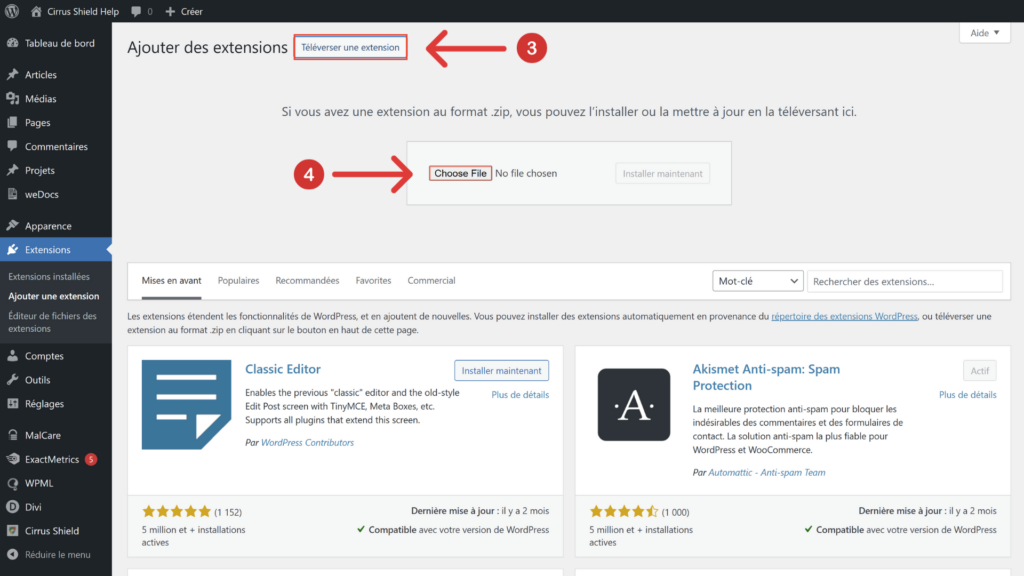
And finally activate it.

2- Connect to your Cirrus Shield environment
Once the plugin installed, a “Cirrus Shield” tab will appear in WordPress.

Click on this tab and sign in to your Cirrus Shield CRM account by inserting your username and password.
By signing it to your CRM environment, you will be able to create forms adapted to your data model. In fact, these forms will include the objects and fields present in your Cirrus Shield environment.
3- Creating the form
Let’s take for example the creation of a form that will let your leads submit a Demo request from your solution.
To create a new form, click on “Add New Form” button.

Select the object from Cirrus Shield taht will receive the data of your form. In this case, the “Lead” object.
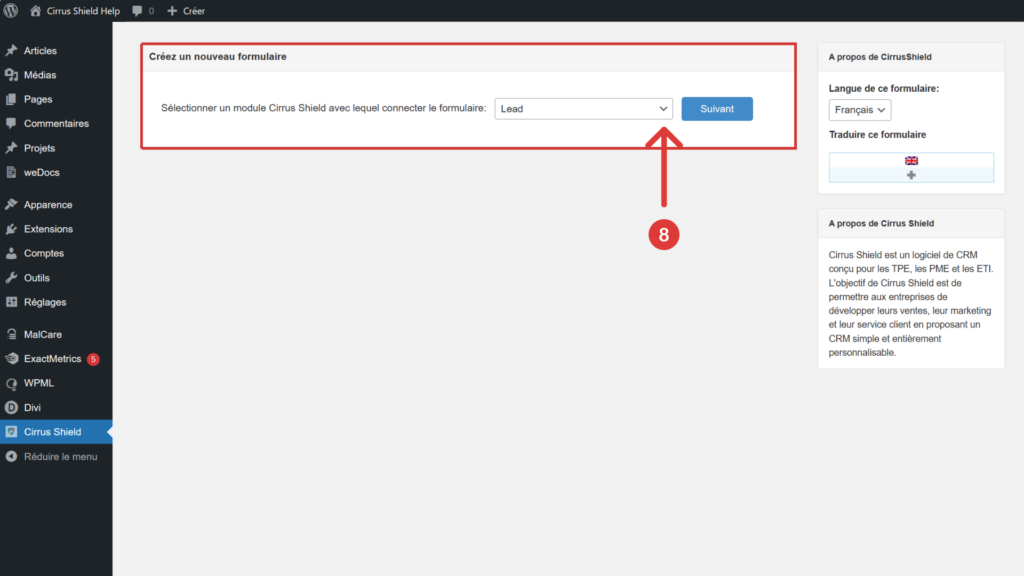
The creation interface of the form is composed from the elements below:
- An html editor that lets you edit the code directly.
- A menu called “Add a new field” to add new fields to your form.
- An overview section of the form to preview all the modifications.

The field will automatically be added to your form (htlm editor). To add a new field, you just have to select it from the picklist names “Add a new field” et then click on “Add to form”.
Note that this picklist does not contain the calculated Cirrus Shield fields (such as the formulas, the rollups and the autonumbers) neither the one that are related to other objects (lookups and multi lookups)
The field names that are in the form are customizable. You can, for example, rename the “Submit” button to “Send”, make the field mendatory or insert a value by default in the field.


To change the fields order, select the field from de opening <p to the end of </p, and copy paste it wherever you want.

Note on Checkbox items
Due to the way HTML manages checkboxes you need to make sure to add a [value=”1″] to the inline HTML of a checkbox item. Indeed the value attribute is one which all <input>s share; however, it serves a special purpose for inputs of type checkbox: when a form is submitted, only checkboxes which are currently checked are submitted to the server, and the reported value is the value of the value attribute. If the value is not otherwise specified, it is the string on by default and this string is not accepted by Cirrus Shield who expects a 1 for a checked checkbox.
Lower, you will also find other options to customize your form:
- Add a compliance note ;
- Add a Captcha ;
- Add a term acceptence checkbox ;
- Form Style.

Click on « Save »to save the modifications done.
4- Customization of the registration process
Once your form is created, you will be able to configure the different steps of the registration process:
- Email notification when submitting the form;
- Sending a confirmation email to subscribers;
- The activation of the Double Opt-in which sends a confirmation request by email to the address provided in the form;
- Redirecting subscribers to a confirmation page after registration.

Click “Save” to save the changes made.
Customization the confirmation email (advanced settings)
You can add confirmation email templates in the Cirrus Shield plugin for WordPress. To do this, you need to extract the contents of the zip file containing the plugin (downloadable from this page). The email templates can be found in the “\inc\templates\confirm” subdirectory. Simply add your email template to this folder, you can take the example of the default email template to make your template.
Once the files of your email template are added to this directory, you must recreate the .zip file containing all the plugin files and upload this plugin to wordpress. If WordPress asks you if you want to overwrite the old version, you have to accept and install the new version you built.
5- Customize your subscription messages
Your can personalize the subscription messages of your form
- Validation message after sending the form ;
- Error message ;
- A message when someone tries to submit a form a second time. This is verified if the submitter’s email already exists in the CRM ;
- A message when the email format is invalid ;
- A message when a mendatory field is not filled ;
- A Message present in the confirmation email sent back to the submitter.

Click on “Save” to save all the modifications
6- Add the form to your WordPress page
Once your form is created and saved, you will have to integrate it to your WordPress web site. In order to do that:
Click on the “Back to form’s list” button.
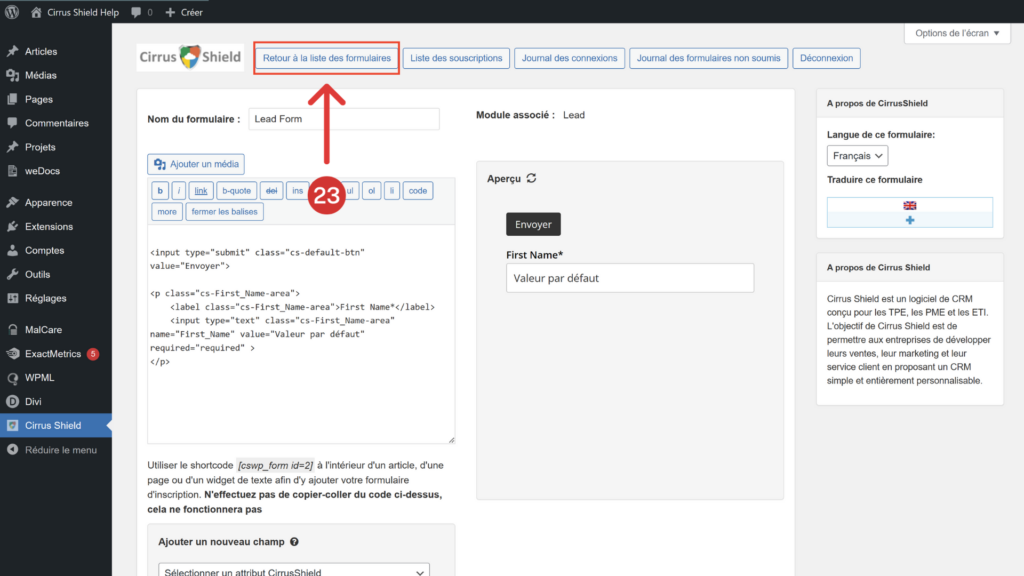
Copy the “Shortcode” at the right side of the form’s name
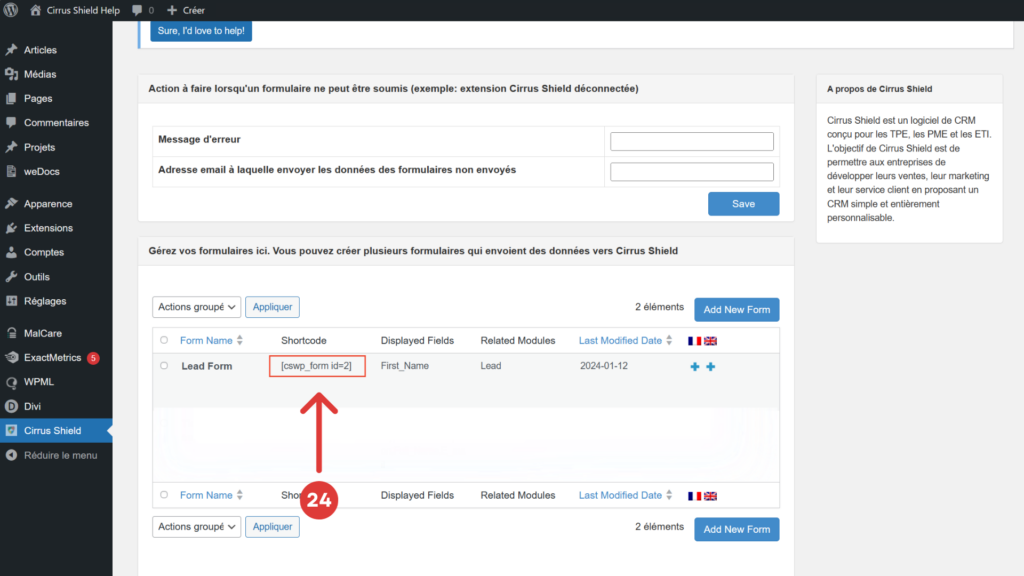
Paste this “Shortcode” on your WordPress page in a “Widget Code Court” bloc type.

Save the modifications. The form will now appear in this section
7- History of submissions and errors
The Cirrus Shield extension of WordPress save in the history all the submissions of the form, the connexion history to the API as well as the non submitted forms. This action is useful in case of an issue with the extension.
To access to the form’s submissions history, click on the “Go to subscription List” button.
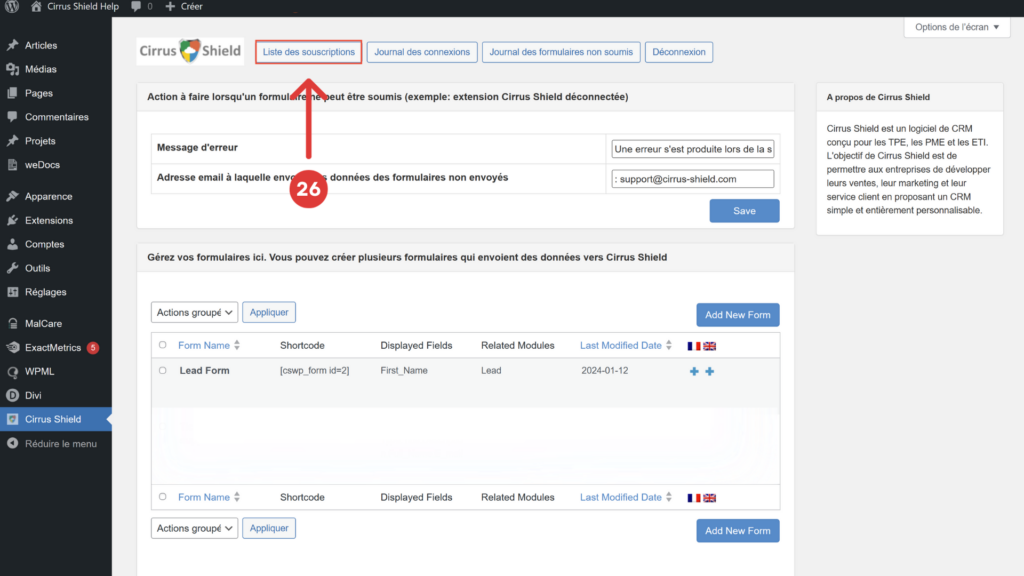
A table will appear with the information below:
- The module and the corresponding form that has been submitted.
- The information submitted through the form as well as the date and time of submission.
- Data sent by the form to the Cirrus Shield API
- And those received in return from the Cirrus Shield API.
To access to the API’s connexion history, click on the “Go to Sign-in Log” button. The page will show the history of all the connexions with Cirrus Shield’s API
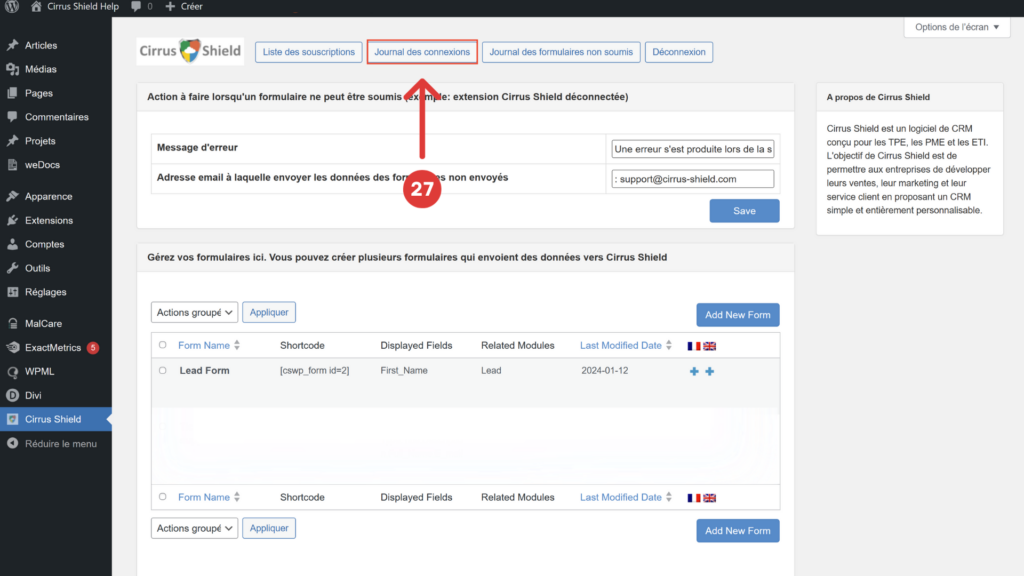
It can sometimes happen that the submission of a form cannot reach Cirrus Shield, in this case you have the following elements:
- You can configure the message that will appear in this situation in the “Error Message” field.
- The extension will still send the form data to the address specified in the “Email address to which to send data from unsent forms” field

- You can access to the data history sent by the form, but that couldn’t reach Cirrus Shield for any reason. for that, click on ‘Go to Un-submitted Forms Log”.
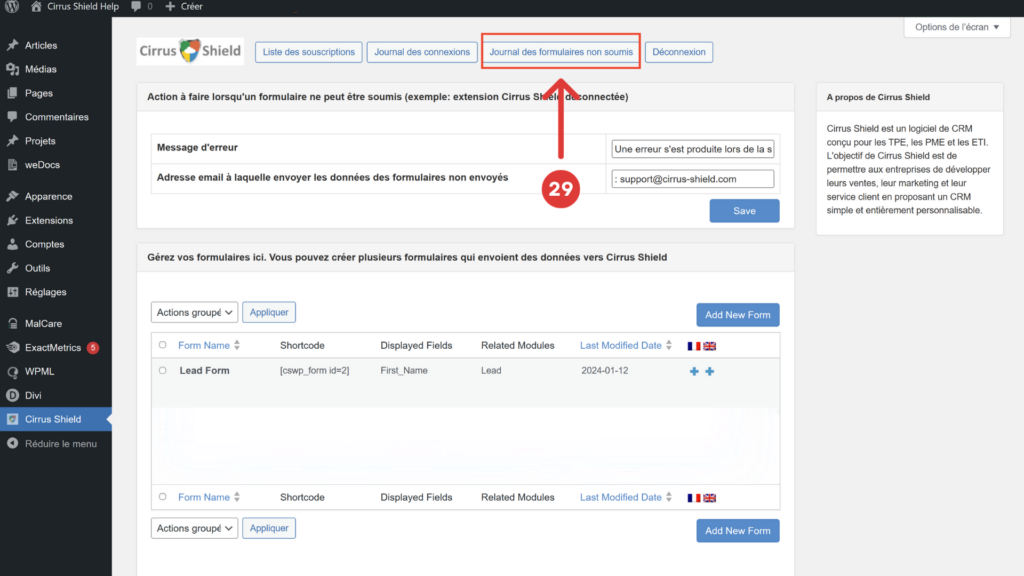
Finally, the “Log out” button allows you to disconnect the extension with Cirrus Shield.
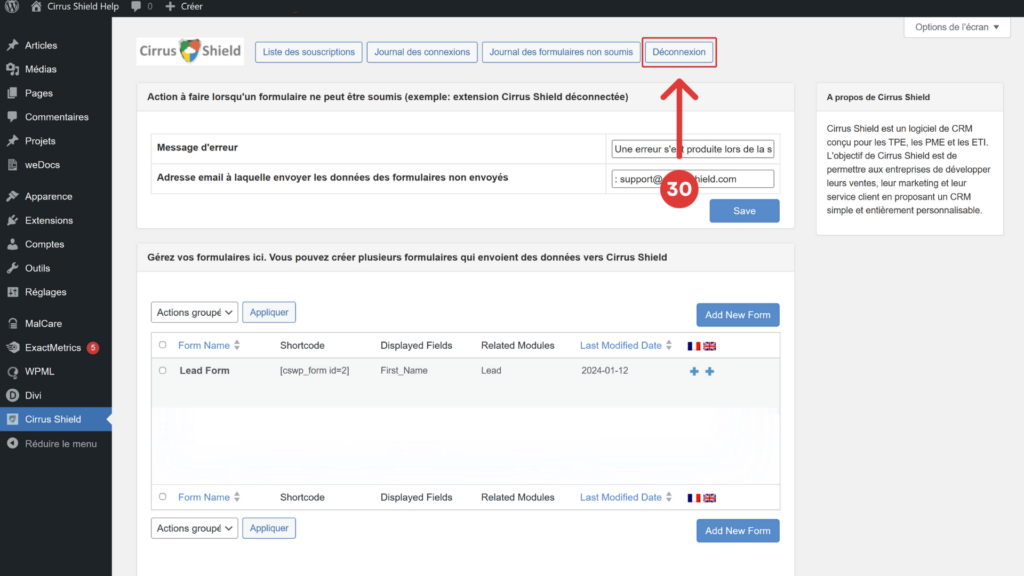
When your extension is disconnected the existing forms are still available on your site but will no longer send the data to Cirrus Shield. However, you continue to receive data from these forms by email at the address configured in the “Email address to which to send data from unsent forms” fiel